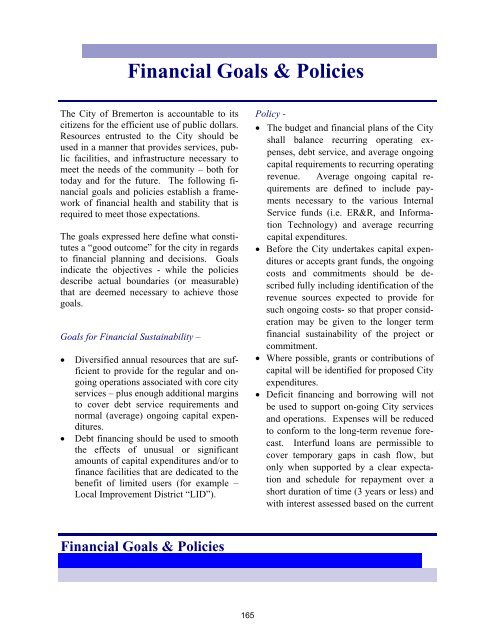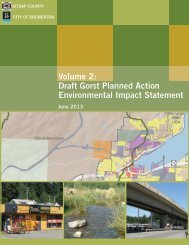2013 Annual Budget - City of Bremerton
2013 Annual Budget - City of Bremerton
2013 Annual Budget - City of Bremerton
You also want an ePaper? Increase the reach of your titles
YUMPU automatically turns print PDFs into web optimized ePapers that Google loves.
Financial Goals & Policies<br />
The <strong>City</strong> <strong>of</strong> <strong>Bremerton</strong> is accountable to its<br />
citizens for the efficient use <strong>of</strong> public dollars.<br />
Resources entrusted to the <strong>City</strong> should be<br />
used in a manner that provides services, public<br />
facilities, and infrastructure necessary to<br />
meet the needs <strong>of</strong> the community – both for<br />
today and for the future. The following financial<br />
goals and policies establish a framework<br />
<strong>of</strong> financial health and stability that is<br />
required to meet those expectations.<br />
The goals expressed here define what constitutes<br />
a “good outcome” for the city in regards<br />
to financial planning and decisions. Goals<br />
indicate the objectives - while the policies<br />
describe actual boundaries (or measurable)<br />
that are deemed necessary to achieve those<br />
goals.<br />
Goals for Financial Sustainability –<br />
• Diversified annual resources that are sufficient<br />
to provide for the regular and ongoing<br />
operations associated with core city<br />
services – plus enough additional margins<br />
to cover debt service requirements and<br />
normal (average) ongoing capital expenditures.<br />
• Debt financing should be used to smooth<br />
the effects <strong>of</strong> unusual or significant<br />
amounts <strong>of</strong> capital expenditures and/or to<br />
finance facilities that are dedicated to the<br />
benefit <strong>of</strong> limited users (for example –<br />
Local Improvement District “LID”).<br />
Policy -<br />
• The budget and financial plans <strong>of</strong> the <strong>City</strong><br />
shall balance recurring operating expenses,<br />
debt service, and average ongoing<br />
capital requirements to recurring operating<br />
revenue. Average ongoing capital requirements<br />
are defined to include payments<br />
necessary to the various Internal<br />
Service funds (i.e. ER&R, and Information<br />
Technology) and average recurring<br />
capital expenditures.<br />
• Before the <strong>City</strong> undertakes capital expenditures<br />
or accepts grant funds, the ongoing<br />
costs and commitments should be described<br />
fully including identification <strong>of</strong> the<br />
revenue sources expected to provide for<br />
such ongoing costs- so that proper consideration<br />
may be given to the longer term<br />
financial sustainability <strong>of</strong> the project or<br />
commitment.<br />
• Where possible, grants or contributions <strong>of</strong><br />
capital will be identified for proposed <strong>City</strong><br />
expenditures.<br />
• Deficit financing and borrowing will not<br />
be used to support on-going <strong>City</strong> services<br />
and operations. Expenses will be reduced<br />
to conform to the long-term revenue forecast.<br />
Interfund loans are permissible to<br />
cover temporary gaps in cash flow, but<br />
only when supported by a clear expectation<br />
and schedule for repayment over a<br />
short duration <strong>of</strong> time (3 years or less) and<br />
with interest assessed based on the current<br />
Financial Goals & Policies<br />
165

















